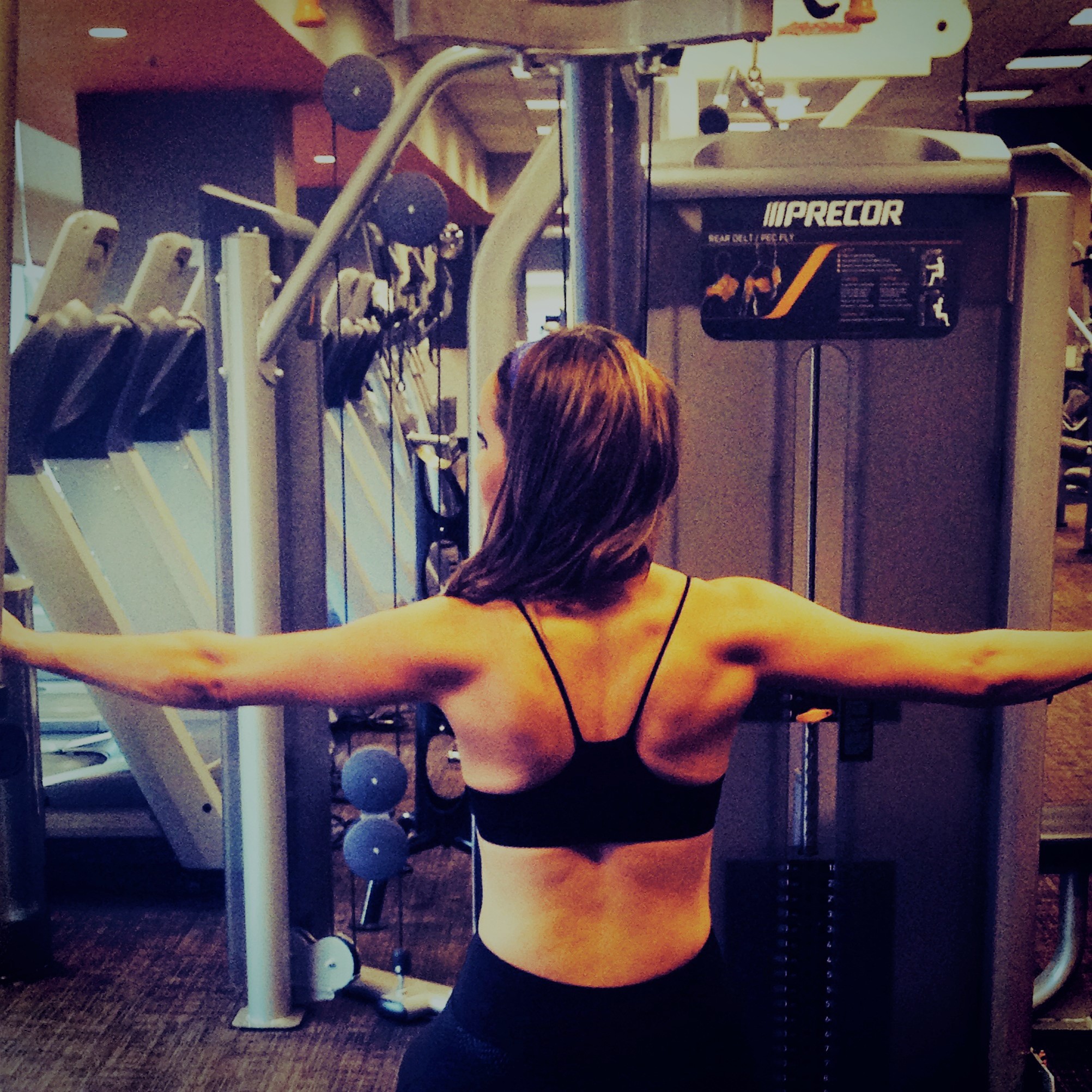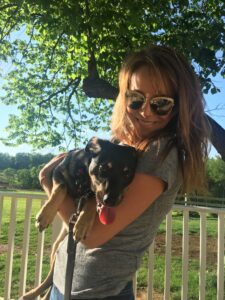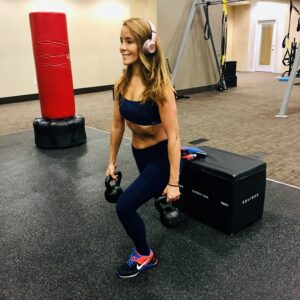It is really hard, if not impossible, to make noticeable changes to your body without incorporating strength training. Most people shy away from it or do it wrong. In this post, I will share what I learned from training with numerous top-tier trainers over the years.
What is strength training?
The term “strength and conditioning training” refers to the format of exercise which highlights building the strength, size, and endurance of skeletal muscle. It can include these types of workouts as tools, but it is also good to be aware that you don’t have to be picking up a weight or kettlebells to do strength training. Working on agility, balance, and functional movements are all a part of this. Therefore, this category also includes “animal flow” type of movements like bear crawls and frog walks.
Strength training benefits
The main benefit of strength training is that it boosts metabolism. While all exercise boosts metabolism, strength training helps you to burn calories while you are at rest.
But it’s not just about calories.There are many benefits of strength training for the heart. Strength training is known to improve cardiovascular health, which is something that the heart needs to be healthy. When it comes to the heart, it’s all about exercise.
Strength training equipment
The thought of strength training often conjures images of heavy bench presses and clanging metal. But there are so many ways to strength train that can be done with minimal or no equipment. The basic types of “weight” you can use are the following:
- Body weight: using your own body weight and the force of gravity to perform various movements (e.g., pushups, squats, planks, pullups, and lunges)
- Free weights: equipment not bound to the floor or a machine, such as dumbbells, barbells, or kettlebells
- Resistance bands/loop bands: rubber bands that provide resistance when stretched
- Weight machines: machines with adjustable weights or hydraulics attached to provide resistance and stress to the muscles
- Suspension equipment: ropes or straps that are anchored to a sturdy point with which a person uses their body weight and gravity to perform various exercises
Generally, the format of strength training consists of three types: pyramids, circuits, or AMRAP. Here is the difference between the three:
- Pyramid training is successively doing the same movement and taking a rest period in between. For example, if you were doing a set of 10 push-ups, you would do one set, rest for 30 seconds, and then complete the next two sets before moving onto the next exercise.
- Circuit training is a succession of 3-4 movements repeated in several sets, usually with minimal rest so that the heart rate stays elevated.
- “AMRAP” is an acronym for “as many reps as possible,” meaning doing reps of a certain exercise until muscle failure (i.e., bicep curls until your arms are on fire.).
A comprehensive formula- LISS + HIIT + STRENGTH = FIT!
I follow an exercise regime based on steady state cardio 5 days a week, and high intensity interval training twice a week, strength training twice a week, and precision training (yoga, Pilates or barre) twice a week. The formula I follow for working out is as follows:
- 1-2 15-20 minute HIIT training sessions a week
- 10-60 min of steady state cardio(LISS OR MISS) 4-5 times a week
- 3-4 resistance training sessions twice a week
- 1-2 precision training sessions a week
- 1 complete rest day
Note that much of my steady state cardio is done while on work calls; therefore during the week, my net time spent working out daily is 20-45 minutes.
You can read more about HIIT here and Cardio here. If you want more info now, including an explanation of HIIT, LISS, and MISS, you can review my post on best programs for weight loss. I will also separately explain this formula and why it works.
Circuit training options
The most important aspect of a good circuit training program is to stay organized, so here are the links to my different templates.
Exercise Template Links
- Customizable DAOFitLife Exercise Plan Google Sheet Template (updated for week 2)
- Downloadable DAOFitLife Exercise Plan Excel Document
- Printable DAOFitlife Exercise Plan PDF
Read my review of strength training apps here:
If you need help deciding which app is right for you then go back to my fitness app decision tree.
Precision training options
Yoga, Pilates and barre are the main types of precision training. Precision training is what gets those little biddy muscles start to pop, like that hip dip or teardrop shoulder. These also get your core strong, so you can hold.plank.forever.
Once we emerge further out of COVID, I will do my workout studio review. For now let me refer you to my yoga, barre and Pilates app recommendation.
This type of training is also where a zoom class would be a good exprience, especially when it is not as familiar to you. For yoga, I would recommend trying a streaming class from one of your local studios.
I have apps that I recommend for yoga, barre and pilates here:
https://daofitlife.com/tools/best-barre-yoga-and-pilates-apps/
Best precision training zoom class options (in pandemic):
Hot house yoga– Run by the Yax brothers Chris and John, with the support of their family, this beach-bound hot yoga studio is where my practice got next level. Now many of the classes are available on live stream, at the schedule at the link.
Cocktails & Relevés Barre – Run by two professional barre teachers, Amy and Naz, this is a 5-day a week zoom barre program with classes focused on arms, abs, legs, booty, and full body. There are several mid-day express classes which make it so easy to take a quick lunch break class. There is also weekly “flow” class similar to yoga, and lots of social get togethers involving cocktails (of course) and coffee.
If you live in an area with a Solidcore, fortunately, the studios have stayed open in an “open gym format”. I am fortunate enough to live across the street from one. Basically, the class s a megaformer style class that is INSANELY challenging for your core and full body. To learn more about Solidcore and their open gym format, click here and here.
The DAOFitLife Workout and sample workout
Here is some guidance on how to design a circuit training program. In all of the moves I have described below, I have links to explain what they are but also that give guidance on form. If you haven’t trained or worked with a trainer, you will want to make sure that you do take precautions to learn the proper form. I would recommend hiring a trainer for at least a few sessions to get at least a few functional and alignment pointers. It is tricky during “Corona-time”, so consider also purchasing one of the fitness books I recommend that give more guidance on basic strength training moves.
Here are some tips to maximize the effectiveness strength training:
- Don’t shy away from heavier weights. Heavier weights will NOT make your bulky. In fact, they will make your muscles leaner.
- Incorporate some cardio / HIIT / velocity movements in your circuits, like ropes, boxing, high knees, or mountain climbers. This keeps your heart rate up.
- Try to go from one movement straight to another and only rest between sets. Again, this make sure your heart rate is up, thus burning more fat.
- Incorporate “drop sets” – which mean staring with a heavier weight, then going down in weight and increasing reps. For example, with bicep curls, if you lift 10s or 12s for 10 reps, then have your last set drop down to 5 reps and do 20 reps. This is also known as “flooding.”
- Don’t forget your back. A lot of times women especially focus on the front, as in what you can see in the mirror, like biceps and legs. Devote at least one body workout a week to the back, including upper back, lats, hamstrings, and calves. This will include exercises like Romanian deadlifts, tricep pressdown, and rows.
- Mix it up. Keep your body guessing by varying the weights, number of reps, and movements. This only requires a little bit of creativity. For example, instead of doing a regular pushup, do a tricep pushup, or a negative (slow) pushup). Or introduce instability – for example, raise a leg or do shoulder taps during plank, or do an upper body standing movement like bicep curls with your leg elevated. Sometimes I plan this and sometimes it’s spontaneous. Don’t be afraid to be a little playful. Working out is supposed to be fun, and push you beyond your comfort zone.

Sample workout library for circuit training program
For each circuit, pick an upper body exercise, a lower body exercise, a core exercise. Then pick a “finisher” at the end from the finisher menu and do it for one straight minute.
Make sure if you train legs one day, you train a different part of the body (back, chest, or arms) the next. The only exception is core and abs – you can train those every day.
Warm up
- World’s greatest stretch– from a down dog position, go into a low lunge position and raise one arm in a twisting motion, hold for 10 seconds each side
- Cat cow – Arch back up like a cat, doming shoulders; contract shoulder blades and drop belly. Do 5-10 reps
- Bird dogs– From tabletop, extend opposite hand and leg, hold for 10 seconds, draw back in; repeat on other side. Do 5 reps each side
- Down dog to plank repeat in a wavelike motion- do 10 reps
- Yoga pushups- from down dog, go to plank position and then do a tricep pushup, go back to down dog – do 5-10 reps
- Roll ups– lie down with arms over head, using core to slowly roll up to a seat and lean over to touch as far down to toes as possible; roll back to an upright position and then slowly roll back down.- Do 8 reps
- 30 sec plank hold- forearm or pushup position
- Deadbugs with alternating leg kicks – lying on the floor and alternating the arm and leg kicking out while engaging core- Do 5 repos each side
- Shoulder taps– in a plank position, engage core and quickly touch opposite shoulder, alternating between 10-20 reps
- Band walks – with a leg band band around just below needs, bend down into a squat position and shuffle side to side in one direction, after 10 steps shuffle back to other side.
Legs
- Single leg romanian deadlift with weights (also known as RDL)
- Side squat
- Back lunges
- Kettlebell swings
- Bridges – including single leg , and with band
- Fire hydrants
- Plank leg raises– either on forearms or on hands
- Bulgarian split squat
- Frog pumps
Finishers (go hard for a minute at the very end)
- Burpees
- Fast push-ups
- Plank up downs
- Tuck jumps
- Plank jacks
Core / Full body
- Plank hold 30 seconds
- Plank saw
- Squirms
- Bear Crawl
- Military crawl with sliders
- Bicycle crunches
- Stability ball sit ups
- Spiderman push ups
- Plank rows
- Turkish get up (warning that this is a tough one, try it with no weight at first)
- Side plank with leg raises – the link has modifications
- Plank moguls
Back
Chest
- Barbell Chest press – flat, angled (you can also use dumbbells)
- Bench Incline Chest press – single alternating, double
- Push ups – negative (slow down, fast up)
- Destabilizing push-up with legs on Swedish ball or bench
- Destabilizing push-up with hands on medicine ball or Swedish ball
Other chest exercises are here.
Shoulders
- Lateral raise
- Upright row
- Front raise
- Shoulder overhead press, double or alternating
- Forearm plank with arm reach
Arms
- Bicep curls
- W curls
- Hammer curls
- Tricep kickbacks
- Chatarangua/Tricep pushups (narrow width, elbows point back directly)
- Plank rows with tricep extension
- Chin ups (advanced); use the assisted machine first, get someone working on the floor to show/help you
- Tricep dips
Finisher exercises
- Skaters
- Mountain climbers
- Jump rope (either with a real or imaginary one)
- High knees
- Bear kick throughs
- Suicides
- Handstand Donkey kicks
- Treadmill/bike/elliptical sprint one minute (max speed)
Cool down
Sample workouts
Workout 1
Warm-up:
Circuit 1: (Do 15 reps of each on each side)
- Single leg romanian deadlift- with a dumbbell in each hand, slowly lower down raising your back leg so it is parallel to the ground. Keep your chest high and back straight.
- Bicep curl – either using an E-Z curl bar or dumbbells, start with arms straight and curl weights all the way to your shoulders. Hold at the top for a second and then slowly release down.
- Oblique crunches- the key is to do these slowly. Jerking back and forth will not work your abs and can harm your back.
Circuit 1 (Photo credit: @lioputra – stock.adobe.com )
Circuit 2: (Do 10-5 reps of each on each side)
- Side lunge: Stand with your feet wider than your shoulders, feet facing forward then gently push your hips back and lean to your right side. Come back to standing, then repeat. Do 15 on the right side before switching to the left.
- Chest press – on a bench or the floor, raise dumbbells over the head and then slowly lower them so your elbows are at a 90 degree angle. Press up in an explosive motion. On a more advanced level, you can do a bench press, but start by only using the bar before adding weights (the average bar is about 45 pounds).
- Plank rows: Take a set of dumbbells and hold them as you get into a plank position. Importantly do not flex your wrists. Then raise your right elbow in a rowing motion while you are supported by your left arm. Keep your weight centered and use your core to balance. If you are losing your balance then get on your knees. Alternate lifting right and left.
Circuit 2: Photo Credit @lioputra – stock.adobe.com
From left to right – Side lunge, chest press, and plank row
Workout 2
Circuit 1: (do 20-30 reps of each).
- Kettlebell swings: With a kettlebell or a dumbbell, hold the weight between your legs and then slowly swing your hips back with the kettlebell gripped securely. Use your hips and glutes to thrust the kettlebell to be parallel with your shoulders. Keep your head down. Let controlled momentum guide the kettlebell back down and repeat.
- Tricep dips @lioputra – stock.adobe.com – on a bench or chair, slowly lower your elbows to a 90-degree angle. Then explode up and repeat.
- Mountain climbers – from a plank position, slowly begin to drive your knees toward the chest and then quicken the pace until you are essentially running and raising your heart rate.
Circuit 1 (Photo Credit: @lioputra – stock.adobe.com )
Circuit 2: (Do for 30 seconds each, rest for 10 seconds, then go to the next exercise)
- Bear Crawl – You are on your hands and knees and then you elevate your knees to crawl forward, like a bear!
- Skaters – like the name implies, you hop from side to side with your back leg sweeping behind your front leg. Keep your chest high and push the ground away to go to each side to maximize force.
- Deadbugs Again, self-explanatory name, but you get a really good workout by slowly lowering your legs from tabletop to straight and then back up on an alternating basis.
- Captain chair crunches – if you are in the gym, this is an excellent piece of equipment to take advantage of gravity and working your lower abs.
Circuit 2: Photo Credits: (clockwise) © Lio Putra | Dreamstime.com; ©vecteezy.com; Vipicreate | Dreamstime.com)
Accesory training playlists
You can find all of my exercise accessory training playlists curated on YouTube on my original 4321 formula post here:
And on my YouTube Channel here:
https://dao.tiny.us/YouTube
Where to get the equipment for at-home
While I fully intend to go back to the gym as soon as it’s reasonably safe, I get that working as well as working out from home may be the new wave of the future. So here are some of my recommendations for a home gym that you can have without too much space or money needed.
You don’t have to be Jeff Bezos to have a tricked-out home gym – in fact, you can have a great one for about 100-200 bucks. Here are some finds categorized by equipment type needed for on-demand/at home workouts
- Dumbbells: The key here is to figure out a couple of weights that you can adapt to a lot of different moves. For example, I can use 8-10 pound dumbbells for bicep curls, single leg deadlifts, tricep exercises, and shoulder presses. The best option for me was to order a weight tree set from Amazon – and if you search around, you can pay less than 20 bucks.
- Battle ropes: You can order the kind that attach to furniture at Toneitup’s online store
- Barre: You don’t really NEED a barre for at home barre workouts; most of the time these are bodyweight or on a chair. But if you really want the feeling, you can order the a mini barre like this one that also has a weight rack.
- Yoga Mat– this recent New York times article recommends several, including Lululemon and Gaiam, which are two of the well-known brands.
- Sliders – these compliment a lot of the barre classes and on-demand workout classes. I like this brand from Amazon which is carpet-friendly.
- Benches – an Ottoman or a coffeetable will do it!
The great dumbbell shortage of 2020 saw a surge in demand for this popular type of equipment; but you can also invest in armbands and legbands (which you can get for decent prices at the Tone it up website). while you are waiting for that to get back in stock (and they are less expensive). If you are really serious about a home gym for post-pandemic times, consider getting the bowflex adjustable weights. It’s much cheaper than a peloton and allows you to change weight from 5 to 52.5 pounds.
Key takeaway
You can and will find your rhythm when it comes to working out. It only takes 3 pillars: Ability, time, and motivation. I have helped you find your motivation and your why. I have helped you with finding the time. The ability may seem daunting at first, but so was your first day at your new job. And look where you are now. You can do that, and you can do this too.











